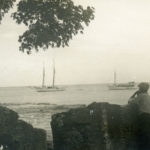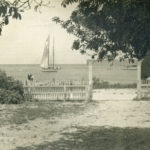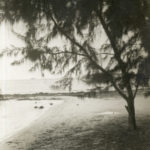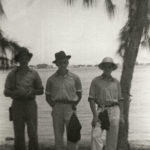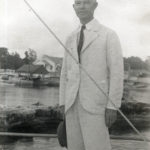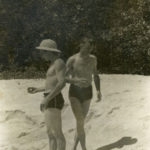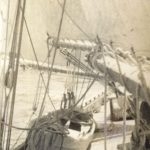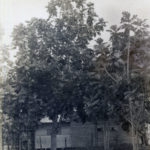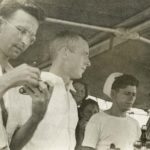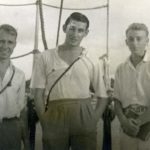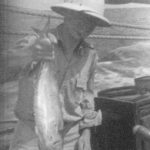Pine Mountain Settlement School
Series 09: BIOGRAPHY – Staff
FRED J. BURKHARD and Friends in the Cayman Islands 1938
Fred J. Burkhard, PMSS Printing Teacher 1937-1940
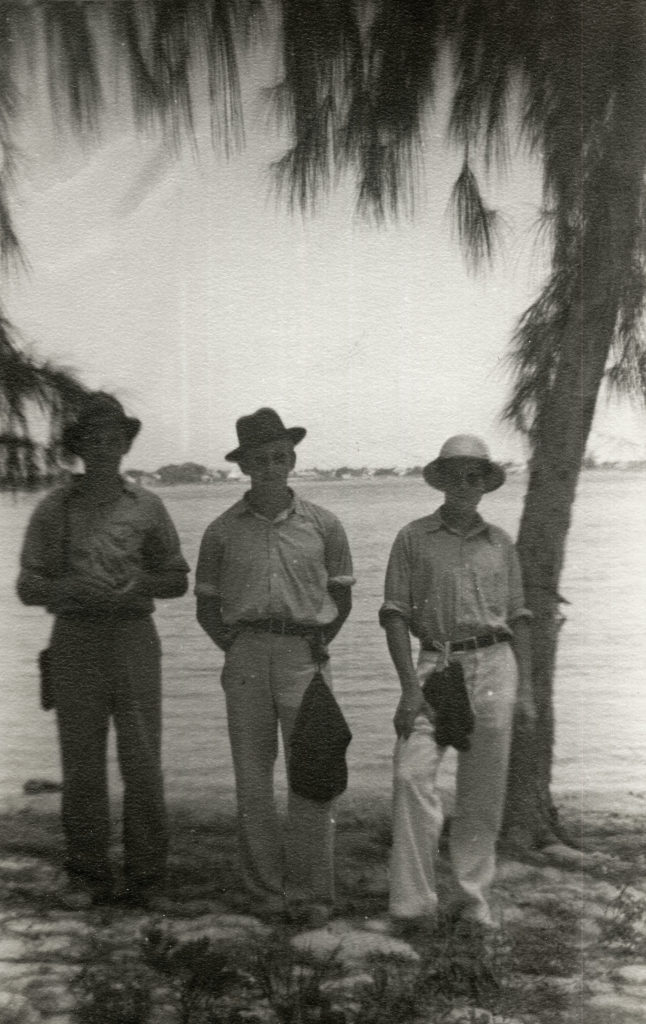
Burkhard in Caymans: Arthur Dodd, August Angel, Fred Burkhard. [burk_grand_cay_006.jpg]
TAGS: Fred J. Burkhard, Elanor Burkhard, Cayman Islands, Grand Cayman Island, WWII, Arthur Dodd, photographs, sailors, yachts, boats, schooners, Caleb Shera, August Angel, vacations, Isle of Pines, Tampa Florida, Nazi German freighter, Glyn Morris, Nazis, espionage, Alice Shera, sea turtles, fishing, canning, Esther Weller (Burkhard), Georgetown, Grand Cayman Island
FRED J. BURKHARD and Friends in the Cayman Islands 1938
In 1938 Fred J. Burkhard, and friends Arthur W. Dodd, August Angel and Caleb Shera, traveled to the Cayman Islands and to Cuba. It was an adventure trip and according to the account of the trip recorded in the autobiography of August Angel, “Trivia & Me,” it had an element of intrigue.
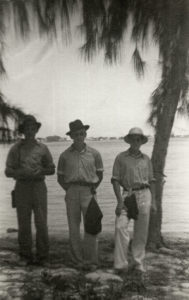
Burkhard in the Caymans: Arthur Dodd; August Angel; Fred Burkhard.
In the years before WWII, several Pine Mountain workers had connections in the Caribbean, Angela Melville, former School Principal and others had family and friends in the Bahamas and in the Caribbean.
Trips by staff to Florida and the Keys were not infrequent as were trips to Mexico. In fact, the staff at Pine Mountain were a restless and far-ranging group during the pre-war years. The expanded trips allowed the staff to continually refresh and return to inspire the students of the School to explore a wider perspective and geography and many did so.
This particular trip was a very interesting one. This short trip to the Cayman Islands by Fred Burkhard, Arthur Dodd, August Angel and Caleb Shera, captures the mood and the pre-war tensions in the months before the United States declared war on Hitler’s Germany. German spies and intrigue in the Caribbean, Cuba and along the southern coast were already underway. This climate of intrigue and espionage made this journey an even more exciting one.
Both Arthur Dodd and Fred Burkhard were photographers but photo images from the trip are few. However, one small postcard suggests that, as expected, Arthur Dodd, a consummate photographer, took the majority of the photographs. A small postcard sent by Arthur Dodd to Esther Weller is of a road on Grand Cayman Island. The postcard is obviously a commercial card that depicts a scene of a road on Grand Cayman. Dodd apparently selected the card and sent it to Esther Weller, the student counselor at Pine Mountain at the time, and also the future wife of Fred Burkhard.
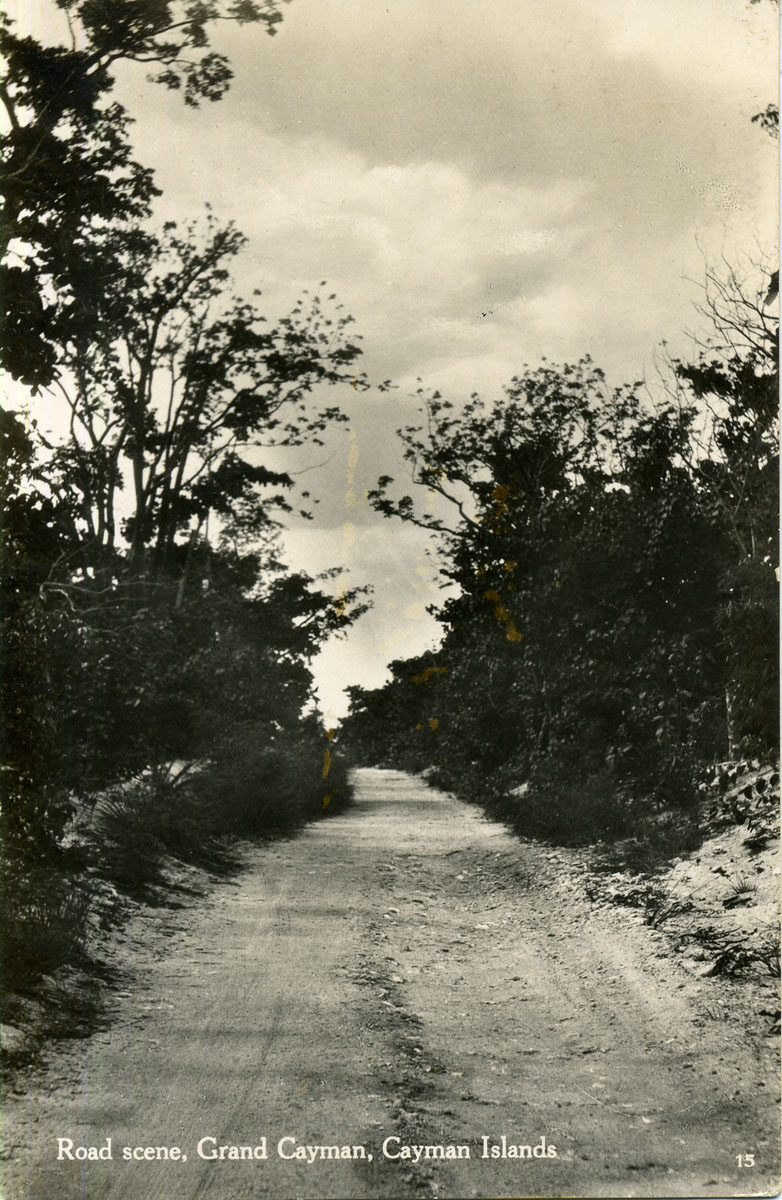
Road Scene, Grand Cayman, Cayman Islands (15)
Dodd writes on the postcard:
Georgetown, G.C., July 16 [1938]
I visited the local school this morning at Georgetown and watched the administration of [the] Regents examination. After leaving I nearly “split my sides” over the pomp and ceremony. We spend every afternoon swimming in the Caribbean where the water is as clear as the air and warm as milk. We love it. Dodd
Remarkably, a short film has been located, shot of the group (probably by Dodd). This most likely explains the dearth of photographs. Further, the few photographs that were developed and printed were on textured paper that did not reproduce detail well. The short film is most likely where the group put their recording energy (unless a cache of photographs still remains to be found of the adventure). Although, it is possible that the excitement of the trip and possibly the financing of an extensive photographic record may have kept the images to a minimum. Or, perhaps, they were just having too much fun. Yet, the quartet has left an interesting and compelling visual and narrative record of their journey and the handful of images suggests a compelling story.
The following photo gallery is an intriguing glimpse into the lives of the Pine Mountain staff and a former student outside the routines of the School and on a unique adventure during the pre-war year of 1938.
The link to the short FILM may be found at the end of this narrative … or click the link here.
THE GRAND CAYMAN INTRIGUE
The intrigue suggested by the following images was documented in the memoir of one of the travelers, August Angel. The memoir, “Trivia and Me,” describes the work environment at PMSS when August Angel became the printing teacher at Pine Mountain in 1937 following the departure of Fred Burkhard. August was also a close friend of Caleb Shera, who came to Pine Mountain as a student when his mother, Alice Shera, came to work as an art teacher at the School following August’s high recommendation of her work. Alice Shera had known August when her other older son, Munns, was August’s classmate and friend when both were attending school at Miami University in Oxford, Ohio.
Shortly after coming to Pine Mountain, Alice Shera developed breast cancer and her health rapidly declined. The untimely death of Alice Shera from cancer in April of 1936 left Caleb emotionally stranded. Friends of Alice and particularly August and Fred Burkhard and Arthur Dodd as the School’s student counselor sought to put Caleb under their care. A close friendship was established among the four travelers, Burkhard, Dodd, Angel and the young Caleb Shera.
The journey of August Angel to Pine Mountain, where he headed the printmaking shop and taught math and science, is an interesting story that may be found in his biography. When August left the School for a new teaching opportunity in Ohio, Fred Burkhard came to the School to teach printmaking. August and his new wife Susie Hall Angel, a former PMSS student, departed Pine Mountain to live and teach at Lincoln High School in Dayton, Ohio. But, this was not before Fred and August had had the opportunity to meet and obviously enjoy the adventuresome spirit they found in each other. It was this budding friendship that led to the call to August to join the PMSS trio on the adventure to the Caymans. Further, the three, August, Dodd, and Shera, had joined in an earlier adventure when they traveled to Mexico and then up into Texas, the Colorado Rockies and on into Yellowstone Park in the Summer of 1934 [?].
When Fred wrote to August and suggested a trip to the Cayman Islands for the four friends, no formal introductions were apparently needed and the quartet made their plans. It would seem that Fred had heard and was influenced by the tales of that earlier journey that Dodd, August and Caleb had by motor-car to Mexico and the Rockies. Dodd was the far-wanderer and organizer, for in 1936, he had also arranged a motor trip to Mexico with his future wife, Georgia Ayers, and two chaperons, Fern Hall and especially the stern eye of Grazia Combs, a school teacher and later school principal at Viper, KY, and friend of Pine Mountain. The motor trip of Dodd, Georgia Ayers, Grazia Combs, and Fern Hall to Mexico in the Summer of 1936 is well documented by Dodd’s photographs.
In the same spirit of adventure, August Angel describes the Cayman Island trip in his memoir, Trivia and Me.
THE CAYMAN ISLANDS ADVENTURE 1938
At the end of my first year at Lincoln High School, I received a letter from Fred Burkhard, the worker who replaced me at the printing job at Pine Mountain Settlement School. He invited me to join him, Arthur Dodd, and Caleb Shera on a trip to the Cayman Islands south of Cuba. I accepted and Susie and I packed up our few clothes and drove to Viper, where she was to stay while I was gone. I left Susie with her family and joined the three at Pine Mountain. Together, we drove in Dodd’s borrowed touring car, the same one driven to Mexico, and headed for Tampa, Florida. We stopped again at the home of Dodd’s mother in Georgia for an overnight rest. She treated us to an excellent breakfast on departure.
Awaiting us in Tampa Bay was a British two-mast schooner with “Captain John” as skipper. Captain John, then in his 60s, had sea legs all his life, following in the footsteps of his father, the previous skipper of the family-owned schooner. The craft, with a crew of five seamen, sailed the Caribbean Sea, making monthly runs between Tampa and the three Cayman Islands, a British dependency. Its cargo was mainly tires, gasoline, and necessities for the islands.
After all were aboard, the schooner was towed out of Tampa Bay to open Gulf waters and steered south toward the shores of southwest Cuba. At one point, we stopped near the coast of a small village and dropped anchor. We went ashore in a dinghy to drop off merchandise and replenish our fresh water and fresh fruit supplies.
After the short shore stop, we semi-circled the Cape de San Antonio of western Cuba, and on to the Isle of Pines (since renamed Isle of Youth by the Castro regime). The island was Cuba’s incarceration center, especially for political dissidents.
It was the summer of 1938 and America was not yet involved in the European fracas – still there was a lot of shipping activity in the Gulf of Mexico, as well as along the shores of the States and Canada. Arriving in port on the Isle of Pines, we made a courtesy call on island officials to register as visitors or tourists. Because of the pre-war time and our dress, we were given undue attention. All four of us – Dodd, Burkhard, Shera, and I – wore khaki clothes and I believe we were mistakenly identified as U.S. Army personnel. We were treated to a lengthy tour of the great prison where male inmates were allowed to have their wives or family visit the cells in private. The entire facility was spick and span and prisoners appeared to tolerate their jail confinement.
Following the prison tour we four Americans were taken by motorboat to an anchored German freighter. We were told that the ship was a fishing factory, but we noticed that it was flying the German Nazi Swastika. After getting permission to go aboard, we were given a tour of the fish-processing machinery, which canned a variety of sea creatures. It was impressive, but clearly planned so that we saw this part of the ship with ordinary-looking German men and women at work. Occasionally we would see fully uniformed naval personnel darting in and out of bulkhead doors. Later, it was disclosed that the fish freighter was a disguised vessel, taking soundings of the Caribbean waters. (During WWII, these marine statistics enabled enemy submarines to do damage to the U.S. coastal shipping business.)
After the Nazi boat tour, the four of us, still in khakis, boarded a large Cuban naval cutter, replete with food, drinks, naval personnel, and young women in naval uniform – another unbelievable attempt to impress us. When the Isle of Pines adventure ended, we returned to Captain John’s schooner with its primitive accommodations: on-board cook stove, on-deck sleeping accommodations, and a careful walk to the fore spar to relieve oneself in the open waters of the Gulf.
Captain John piloted the schooner during the day mostly by compass and the sun. At night, navigation was by compass and the stars. He was at the helm most of the trip and, at times, let us passengers get a thrill at the wheel.
After another day and night of tacking and sailing southeast for about 200 miles, Captain John pulled into Georgetown, Grand Cayman Island, the capital of the three Cayman Islands (including Little Cayman and Cayman Brac). There, we lodged in the only hotel on the island and had our meals in the modest dining room. On one day during the visit, we made a fishing trip with Captain John to catch green turtles off the coast of Yucatan, Mexico. When the turtles were caught, they were put into a hold of the schooner and later released into the open-sea holding pens on Grand Cayman [film shows young Caleb playing in the pen and scrambling out] – to be sold to British canning factories for processing into turtle soup. [Thankfully, these turtles are now protected.]
We did vehicular tours of the 76-square-mile island that had a population of only some 5,000. Our presence caused both speculation and excitement. We were invited to homes and feted with island meals and modest festivities. Fishing, swimming, and beach walks summed up the stay on Grand Cayman.
The return trip to Tampa was made in a 48-hour sail because of the Gulf Stream and tailwind. We adorned the radiator of the Ford touring car with the filum of a large fish that we had caught before arriving in Tampa. (A filum is a threadlike anatomical structure, or bones, with an appearance like filagree) Such a display dried the fish for later meals and proved that we had been somewhere. Plus, we later had a
When Fred Burkhard left Pine Mountain in 1940 to start his newspaper, the Casey County News in Liberty, Kentucky, August, his wife Susie and Ann, their daughter, came back to Pine Mountain. August again picked up the Print Shop responsibilities. It was a short stay, but long enough for the birth of August and Sue’s son Mike Angel. When August left Pine Mountain again, he left to serve in the war effort and it not surprising to find him put to work as a spy. His Rumanian heritage gave him a good command of the German language and while not in uniform, he gathered intelligence for the forces.
The amusing story is told of his clandestine occupation and his unmasking by Director Glyn Morris, who also left Pine Mountain to serve in the war as a Chaplain. While traveling in Europe Morris spotted August Angel in the crowd and shouted out to him, completely blowing his cover!
August relates the story of that unfortunate and fortunate unmasking:
Our CIC 970 detachment group advanced to areas well ahead of the army of occupation and Military Police. In Salzburg, Austria, I was standing, along with curious townspeople, on the sidewalk of the main street, dressed in a Bavarian civilian outfit and watching U.S. troops enter the city. After many trucks transporting GIs had passed, to my utter astonishment I heard my name — August Angel!” — being called from one of the trucks. The caller was none other than Glyn Morris, ex-director of the Pine Mountian Settlement School, who had joined the Army as a chaplain! I quickly found out where he was billeted and visited him that same evening. In the two years I was enlisted as a GI, I had not met any person I knew — and there in Salzburg, thousands of miles from home, came the one and only meeting with a friend. After the usual exchange of news, Mr. Morris saw that my job allowed me freedom to move about the area, so he asked for a favor — find him a violin. I fulfilled his wish.
good story for the captive listeners around the dinner table in Viper [Kentucky].
Excerpts were used with permission from Ann Angel Eberhardt, and transcribed from: August Angel, Trivia and Me: An Octogenarian Mirrors His Twentieth Century, Revised edition September 2007 [first edition December 2006].
GALLERY: FRED J. BURKHARD and Friends in the Cayman Islands 1938
- Burkhard in Caymans: Two men look at two boats in bay, 1937. Caymans[?].[burk_grand_cay_002.jpg]
- Burkhard in Caymans: Sailing ship in bay. [burk_grand_cay_003.jpg]
- Burkhard in Caymans. View of ocean. [burk_grand_cay_004.jpg]
- Burkhard in Caymans: View of beach with tree. [burk_grand_cay_005.jpg]
- Burkhard in Caymans: Arthur Dodd, August Angel, Fred Burkhard. [burk_grand_cay_006.jpg]
- Burkhard in Caymans: Unknown official in white suit on the Isle of Pines [?]. [burk_grand_cay_007.jpg].
- Burkhard in Caymans: Possibly Caleb Shera on left with 2 unknown others. [burk_grand_cay_008.jpg]
- Burkhard in Caymans: The British two-mast schooner with lifeboat on board. [burk_grand_cay_014.jpg]
- Burkhard in Caymans: Small house and trees on Grand Cayman Island. [burk_grand_cay_009.jpg]
- Burkhard in Caymans: Dodd with camera on the “canning boat [?]” [burk_grand_cay_010.jpg]
- Burkhard in Caymans: 3 unknown young men possibly on the Cuban naval cutter. [burk_grand_cay_012.jpg]
- Burkhard in Caymans: Caleb Shera with fish. [burk_grand_cay_013.jpg]
A 9-minute film was made by photographer Arthur Dodd and may be seen here. Note the film date is incorrect. It should read: 1938. FILM: https://youtu.be/y-QmXk67wN4
See Also:
Biographies
ALICE CARTER SHERA Staff
ARTHUR W. DODD Staff Interim Director
AUGUST ANGEL Staff
CALEB SHERA Student
ESTHER WELLER BURKHARD Staff
FRED J. BURKHARD Staff
ESTHER AND FRED BURKHARD Collection Guide

